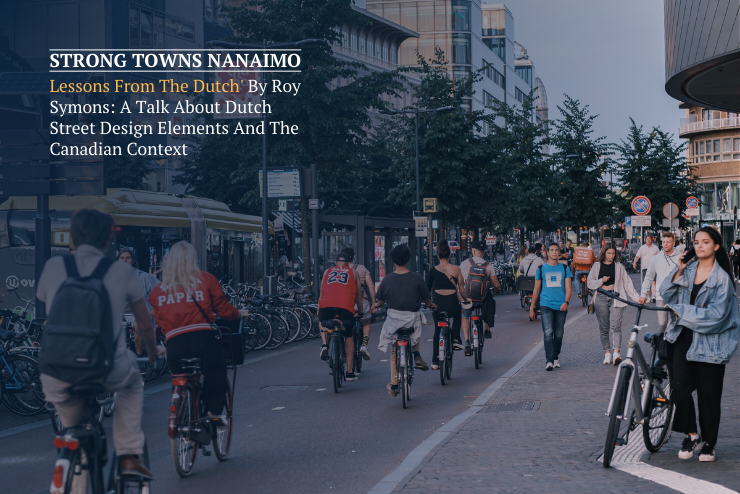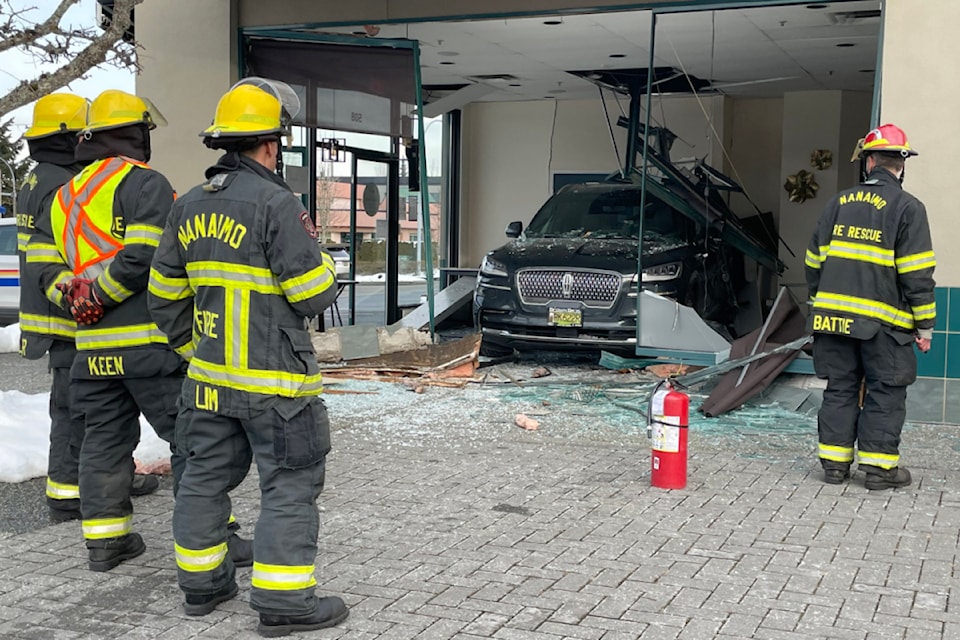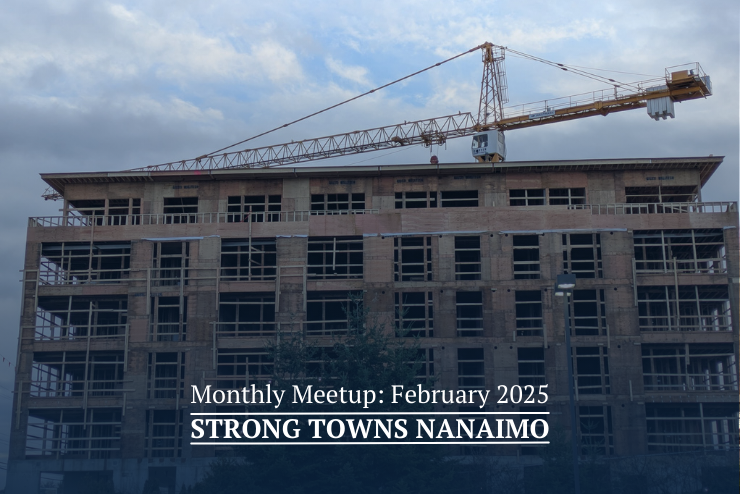Pickup Truck Popularity and Road Safety
More Canadians are buying trucks over sedans every year. Let’s look at the numbers to see how “safe” trucks really are on our roads.
More Canadians are buying trucks over sedans every year. Let’s look at the numbers to see how “safe” trucks really are on our roads.
We need to rethink how we talk about car accidents involving pedestrians in Nanaimo. Pedestrians are seen as obstacles for drivers who are often driving too fast and are too distracted along roads that are all too wide.
Sprawling out often means consuming land, misusing resources, and forcing residents into private cars. Building denser cities with people in mind can contribute to a reduction in greenhouse emissions while also improving the lives of residents.
I'm optimistic about Nanaimo's transportation future. New mobility options, like bike lanes, e-bike share, and the Hullo Ferry help flesh out our transportation system.
Nanaimo plans to amend its zoning bylaws to allow more “missing middle” housing. Fill out the survey and have your say! Survey ends on September 29th, 2023. The survey contains a section for each of the four proposed initiatives and will take approximately 5 to 15 minutes to complete, depending on which initiatives you would like to provide feedback on.
Poké Page in North Nanaimo on Feb. 13 was not wearing reflective gear, nor did it make eye contact with the driver of the SUV.
The Regional District of Nanaimo will increase annual transit service hours by 8,700 starting January 5th, a boost of over 5%, supporting a more connected and sustainable community. This is a major win for transit in Nanaimo! This will help more people choose transit over their personal vehicle, and we think that's neat.
Strong Towns Nanaimo is celebrating City Council’s landmark decision on parking mandates in the downtown core. In a decisive vote, Mayor and Council voted 8-1 to begin the process of eliminating off-street minimum parking requirements for all uses in the Downtown Primary Urban Centre. Staff have been instructed to begin drafting changes to the Parking Bylaw in order to make this a reality. Council will likely have a vote in January according to normal rules for amending bylaws.
A traffic calming measure installed to reduce through traffic inadvertently created new hazards and community frustration, highlighting the need for holistic, interconnected planning. The City of Nanaimo is now applying these lessons to the Country Club Urban Centre Mobility Upgrades project, aiming to create a safer, more integrated transportation network.
A response to the recent op-ed in the Nanaimo News Bulletin. Narrow lanes and pedestrian-friendly improvements on Terminal Avenue and Nicol Street enhance safety, boost local economies, and promote environmental sustainability.
This article is the first in a series following the changes in our city relating to housing. Check back in later to see what Nanaimo has been doing to make Missing Middle Housing possible.
Four Nanaimo residents have already died from vehicular collisions, and it’s only May. Many factors determine if a person hit by a vehicle survives, but building safe streets is by far the most important thing we can do to make our streets safe.
Sprawling out often means consuming land, misusing resources, and forcing residents into private cars. Building denser cities with people in mind can contribute to a reduction in greenhouse emissions while also improving the lives of residents.
Planting street trees goes beyond enhancing the streetscape's beauty; it offers various advantages. Besides creating an aesthetically pleasing environment, street trees contribute to safety by guiding traffic and creating a physical barrier between pedestrians and vehicles. They foster community well-being, encouraging outdoor activities, reducing driving, and increasing neighborhood pride. Additionally, urban street trees help lower energy costs by providing shade, potentially saving households up to 35%.
Despite Nanaimo's own design and safety guidelines advocating for minimizing conflicts between drivers and vulnerable road users, the outcome of the Fifth Street project falls short of creating a truly complete street. The hope remains that future projects, such as the Bruce and Fifth Complete Streets initiatives, will address these concerns and provide safer, more accessible infrastructure for all residents.
The proposed transit exchange in Nanaimo is essential for promoting equity, economic prosperity, and environmental sustainability. Investing in the exchange enhances Nanaimo's livability and productivity. Opposition may not represent the thousands who rely on buses daily. Supporting this initiative aligns with a vision for a more inclusive and accessible city.
Nanaimo plans to amend its zoning bylaws to allow more “missing middle” housing. Fill out the survey and have your say! Survey ends on September 29th, 2023. The survey contains a section for each of the four proposed initiatives and will take approximately 5 to 15 minutes to complete, depending on which initiatives you would like to provide feedback on.
A collaborative project with Sidewalking Victoria! Exploring Nanaimo’s diverse missing middle housing; townhomes, rowhomes, walk-ups, dingbats, duplexes, and everything in between! Our best neighbourhoods are those that contain a wide variety of housing forms.
Recent comments made by a Councillor highlights common misunderstandings and myths about road safety. Strong Towns mean safe streets for all, including drivers and pedestrians.
Exciting new active transportation corridors are sprouting up throughout our town, reflecting a shift in Nanaimoites' mindset regarding transportation. Furthermore, it is evident that city staff are wholeheartedly dedicated to enhancing our streets for the benefit of all residents.
More Canadians are buying trucks over sedans every year. Let’s look at the numbers to see how “safe” trucks really are on our roads.
We need to rethink how we talk about car accidents involving pedestrians in Nanaimo. Pedestrians are seen as obstacles for drivers who are often driving too fast and are too distracted along roads that are all too wide.
A collaborative project with Sidewalking Victoria! Exploring Nanaimo’s diverse missing middle housing; townhomes, rowhomes, walk-ups, dingbats, duplexes, and everything in between! Our best neighbourhoods are those that contain a wide variety of housing forms.
Planting street trees goes beyond enhancing the streetscape's beauty; it offers various advantages. Besides creating an aesthetically pleasing environment, street trees contribute to safety by guiding traffic and creating a physical barrier between pedestrians and vehicles. They foster community well-being, encouraging outdoor activities, reducing driving, and increasing neighborhood pride. Additionally, urban street trees help lower energy costs by providing shade, potentially saving households up to 35%.
This article is the first in a series following the changes in our city relating to housing. Check back in later to see what Nanaimo has been doing to make Missing Middle Housing possible.
Nanaimo plans to amend its zoning bylaws to allow more “missing middle” housing. Fill out the survey and have your say! Survey ends on September 29th, 2023. The survey contains a section for each of the four proposed initiatives and will take approximately 5 to 15 minutes to complete, depending on which initiatives you would like to provide feedback on.
A collaborative project with Sidewalking Victoria! Exploring Nanaimo’s diverse missing middle housing; townhomes, rowhomes, walk-ups, dingbats, duplexes, and everything in between! Our best neighbourhoods are those that contain a wide variety of housing forms.
Upzoning all of British Columbia will help increase housing diversity, improve housing affordability, and enhance walkability in our cities while preserving neighbourhood character.
A traffic calming measure installed to reduce through traffic inadvertently created new hazards and community frustration, highlighting the need for holistic, interconnected planning. The City of Nanaimo is now applying these lessons to the Country Club Urban Centre Mobility Upgrades project, aiming to create a safer, more integrated transportation network.
Despite Nanaimo's own design and safety guidelines advocating for minimizing conflicts between drivers and vulnerable road users, the outcome of the Fifth Street project falls short of creating a truly complete street. The hope remains that future projects, such as the Bruce and Fifth Complete Streets initiatives, will address these concerns and provide safer, more accessible infrastructure for all residents.
There are loads of changes coming to Nanaimo! The Mary Ellen roundabout is now complete in the North End. The Hullo fast ferry is slated to launch in June. And, Nanaimo city council approves new low-rises and condos downtown.
The roundabout is already seeing use! Drivers and pedestrians can now safely leave the once-notorious Woodgrove Crossing parking lot.
Our group sees the development partnership of Te’tuxwtun as an opportunity to add to the increasing vitality and diversity of the Harewood Neighbourhood.
The proposed transit exchange in Nanaimo is essential for promoting equity, economic prosperity, and environmental sustainability. Investing in the exchange enhances Nanaimo's livability and productivity. Opposition may not represent the thousands who rely on buses daily. Supporting this initiative aligns with a vision for a more inclusive and accessible city.
Exciting new active transportation corridors are sprouting up throughout our town, reflecting a shift in Nanaimoites' mindset regarding transportation. Furthermore, it is evident that city staff are wholeheartedly dedicated to enhancing our streets for the benefit of all residents.
There are loads of changes coming to Nanaimo! The Mary Ellen roundabout is now complete in the North End. The Hullo fast ferry is slated to launch in June. And, Nanaimo city council approves new low-rises and condos downtown.
Upzoning all of British Columbia will help increase housing diversity, improve housing affordability, and enhance walkability in our cities while preserving neighbourhood character.
The roundabout is already seeing use! Drivers and pedestrians can now safely leave the once-notorious Woodgrove Crossing parking lot.
I'm optimistic about Nanaimo's transportation future. New mobility options, like bike lanes, e-bike share, and the Hullo Ferry help flesh out our transportation system.
Strong Towns Nanaimo is celebrating City Council’s landmark decision on parking mandates in the downtown core. In a decisive vote, Mayor and Council voted 8-1 to begin the process of eliminating off-street minimum parking requirements for all uses in the Downtown Primary Urban Centre. Staff have been instructed to begin drafting changes to the Parking Bylaw in order to make this a reality. Council will likely have a vote in January according to normal rules for amending bylaws.
We need to rethink how we talk about car accidents involving pedestrians in Nanaimo. Pedestrians are seen as obstacles for drivers who are often driving too fast and are too distracted along roads that are all too wide.
A traffic calming measure installed to reduce through traffic inadvertently created new hazards and community frustration, highlighting the need for holistic, interconnected planning. The City of Nanaimo is now applying these lessons to the Country Club Urban Centre Mobility Upgrades project, aiming to create a safer, more integrated transportation network.
This article is the first in a series following the changes in our city relating to housing. Check back in later to see what Nanaimo has been doing to make Missing Middle Housing possible.
Our group sees the development partnership of Te’tuxwtun as an opportunity to add to the increasing vitality and diversity of the Harewood Neighbourhood.
Our group sees the development partnership of Te’tuxwtun as an opportunity to add to the increasing vitality and diversity of the Harewood Neighbourhood.
Four Nanaimo residents have already died from vehicular collisions, and it’s only May. Many factors determine if a person hit by a vehicle survives, but building safe streets is by far the most important thing we can do to make our streets safe.
Despite Nanaimo's own design and safety guidelines advocating for minimizing conflicts between drivers and vulnerable road users, the outcome of the Fifth Street project falls short of creating a truly complete street. The hope remains that future projects, such as the Bruce and Fifth Complete Streets initiatives, will address these concerns and provide safer, more accessible infrastructure for all residents.
Recent comments made by a Councillor highlights common misunderstandings and myths about road safety. Strong Towns mean safe streets for all, including drivers and pedestrians.
Poké Page in North Nanaimo on Feb. 13 was not wearing reflective gear, nor did it make eye contact with the driver of the SUV.
A response to the recent op-ed in the Nanaimo News Bulletin. Narrow lanes and pedestrian-friendly improvements on Terminal Avenue and Nicol Street enhance safety, boost local economies, and promote environmental sustainability.
Four Nanaimo residents have already died from vehicular collisions, and it’s only May. Many factors determine if a person hit by a vehicle survives, but building safe streets is by far the most important thing we can do to make our streets safe.
Despite Nanaimo's own design and safety guidelines advocating for minimizing conflicts between drivers and vulnerable road users, the outcome of the Fifth Street project falls short of creating a truly complete street. The hope remains that future projects, such as the Bruce and Fifth Complete Streets initiatives, will address these concerns and provide safer, more accessible infrastructure for all residents.
Recent comments made by a Councillor highlights common misunderstandings and myths about road safety. Strong Towns mean safe streets for all, including drivers and pedestrians.
More Canadians are buying trucks over sedans every year. Let’s look at the numbers to see how “safe” trucks really are on our roads.
We need to rethink how we talk about car accidents involving pedestrians in Nanaimo. Pedestrians are seen as obstacles for drivers who are often driving too fast and are too distracted along roads that are all too wide.
Sprawling out often means consuming land, misusing resources, and forcing residents into private cars. Building denser cities with people in mind can contribute to a reduction in greenhouse emissions while also improving the lives of residents.
A response to the recent op-ed in the Nanaimo News Bulletin. Narrow lanes and pedestrian-friendly improvements on Terminal Avenue and Nicol Street enhance safety, boost local economies, and promote environmental sustainability.
The Regional District of Nanaimo will increase annual transit service hours by 8,700 starting January 5th, a boost of over 5%, supporting a more connected and sustainable community. This is a major win for transit in Nanaimo! This will help more people choose transit over their personal vehicle, and we think that's neat.
The proposed transit exchange in Nanaimo is essential for promoting equity, economic prosperity, and environmental sustainability. Investing in the exchange enhances Nanaimo's livability and productivity. Opposition may not represent the thousands who rely on buses daily. Supporting this initiative aligns with a vision for a more inclusive and accessible city.
Poké Page in North Nanaimo on Feb. 13 was not wearing reflective gear, nor did it make eye contact with the driver of the SUV.
The Regional District of Nanaimo will increase annual transit service hours by 8,700 starting January 5th, a boost of over 5%, supporting a more connected and sustainable community. This is a major win for transit in Nanaimo! This will help more people choose transit over their personal vehicle, and we think that's neat.
I'm optimistic about Nanaimo's transportation future. New mobility options, like bike lanes, e-bike share, and the Hullo Ferry help flesh out our transportation system.
Exciting new active transportation corridors are sprouting up throughout our town, reflecting a shift in Nanaimoites' mindset regarding transportation. Furthermore, it is evident that city staff are wholeheartedly dedicated to enhancing our streets for the benefit of all residents.
There are loads of changes coming to Nanaimo! The Mary Ellen roundabout is now complete in the North End. The Hullo fast ferry is slated to launch in June. And, Nanaimo city council approves new low-rises and condos downtown.
Planting street trees goes beyond enhancing the streetscape's beauty; it offers various advantages. Besides creating an aesthetically pleasing environment, street trees contribute to safety by guiding traffic and creating a physical barrier between pedestrians and vehicles. They foster community well-being, encouraging outdoor activities, reducing driving, and increasing neighborhood pride. Additionally, urban street trees help lower energy costs by providing shade, potentially saving households up to 35%.



